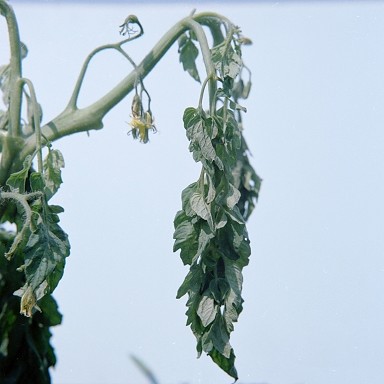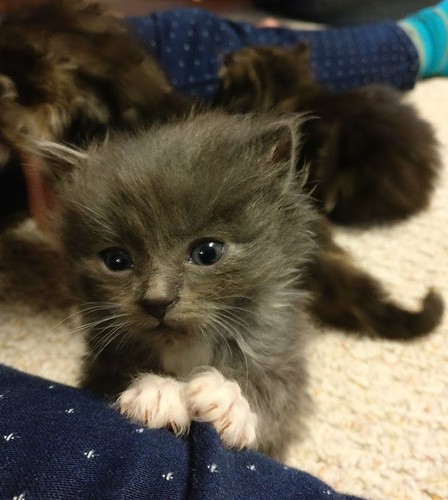Jake Barnett EARTH'S ORGANISMS
microbiome probiotics bacteria biodiversity disease agriculture antibiotics microbial ecology microbes
Dying Tomatoes, Healthy Kittens, and the EMP500: Why you should care about the International Society for Microbial Ecology
Farmer Jiang had a problem. One season, his whole tomato harvest started dying of a horrible disease. He could try using artificial pesticides on his plants, but that would pollute the environment and threaten the health of the people who ate the crops… There had to be a better way. Could it be possible to protect his plants without spraying nasty chemicals? The answer was yes - thanks to a microbial ecologist.

Figure 1. Tomato plants dying of bacterial wilt disease. Image credit: Clemson University - USDA Cooperative Extension Slide Series [Public domain], via Wikimedia Commons
A microbial who? Microbial ecologists are scientists who study tiny living things such as bacteria and fungi (microbes) and how they interact with each other and their environment (ecology). They seek to understand the “invisible rainforests” that live on and in nearly every corner of the Earth - from the microbiome inside our guts to the communities thriving in deep sea hydrothermal vents. In August 2018, I had the privilege of learning about cutting-edge work in this field at the 17th International Symposium on Microbial Ecology (ISME) in Leipzig, Germany. Here are my three takeaways for why you should care about the work of these scientists:
Takeaway 1 - Microbes are both a threat and a savior
Farmer Jiang’s dilemma was solved by a team of microbial ecologists led by Alexandre Jousset at Utretcht University in The Netherlands. The attacker of the tomatoes was a bacterium called Ralstonia solanacearum, which causes wilt disease once it enters the plant (Figure 1). The team wondered if a “microbial shield” of good bacteria, or probiotics, could protect the farmer’s plants from infection by the bad bacteria (a.k.a. pathogens).
After much trial and error with different strains of Pseudomonas spp., a common bacterium known to produce antimicrobial compounds, Dr. Jousset’s team finally found a mix that worked to decrease the wilt disease in the plants! Two things appeared to have happened: 1) a diverse set of good bacteria outcompeted the pathogen for resources, and 2) the Pseudomonas strains produced antibiotic chemicals that directly interfered with the pathogen [1, 2]. So natural microorganisms can replace pesticides! Moral of the story - while one microbe may threaten our food supply, another microbe can be the savior.
Figure 2. Alexandre Jousset speaks eloquently about his “microbial shield” work during the ISME conference “Night of the Microbes” event. Video credit: Helmholtz Centre for Environmental Research, http://www.ufz.de/
Takeaway 2 - Microbes are everywhere and hold vast potential for discovering useful new chemicals
A golf course seems like a pretty boring place to sample for microbes. Sure, other scientists were traveling to remote hot springs or deep ocean vents, but Satoshi Omura chose to collect soil from a golf course near Tokyo. Little did he know that a bacterium found in his humble sample would one day save hundreds of millions of people!
The discovery of ivermectin [3] is an improbable story of curiosity, international collaboration, hard work, and serendipity. It turned out that a compound from the golf course soil was extraordinarily effective at killing parasitic nematode worms. Working with William Campbell at Merck pharmaceutical, Omura discovered that a bacterium called Streptomyces avermectinius produced the substance. Now known as ivermectin, this compound is still used to treat river blindness in patients across the developing world. And its utility doesn’t stop there - you can buy a form of ivermectin called HeartgardⓇ to protect your dog or cat from heartworm infection!

Figure 3. Kittens that take Heartgard for protection from heartworms can thank a microbial ecologist and a soil bacterium from a Japanese golf course. Image credit: Jacob Barnett
More new drug sources are still being discovered. In 2018 a team at the Rockefeller University in New York reported the discovery of malacidins, an entirely new class of antibiotic chemicals that can kill multidrug-resistant pathogens. The researchers searched through DNA sequences extracted from more than 2,000 different soil samples to find these exciting new substances [4, 5]. With more scientists studying microbes from places like wastewater treatment plants, deep ocean vents, human guts, lakes, and hot springs… who knows what will be discovered next?

Figure 4. The soil holds vast potential for discovery of new and useful substances. Image credit: Jacob Barnett
Takeaway 3 - Microbial ecologists are incredibly creative and collaborative problem solvers
When I was in high school I thought that working with 4 or 5 other students on a science project was a “big group”. Well at the ISME Conference I heard about a project involving over 400 scientists! Dubbed the Earth Microbiome Project 500, or “EMP500”, it is the latest version of an ambitious collaboration that examines diverse microbial communities from all over the Earth. The original Earth Microbiome Project (EMP) was started in 2010 and has already catalogued over 200,000 samples. This new effort will apply the latest technology and methods to 500 more samples.

Figure 5. Logo for the Earth Microbiome Project, a collaboration of over 500 investigators seeking to explore patterns in microbial ecology across the globe. Image credit: Earth Microbiome Project, http://www.earthmicrobiome.org/
The EMP500 is just one example of a team of microbial ecologists combining different areas of expertise into solutions that would have been unimaginable years ago. Over 2000 scientists from 60 countries attended the ISME conference. Working with microbes from all over the Earth, they are pushing the boundaries of DNA sequencing and computational technology in exciting new ways. I left the meeting feeling inspired and hopeful that this large, energetic group of brilliant thinkers are charging ahead toward a better future.
References:
[1] Hu, J., et al. “Probiotic Diversity Enhances Rhizosphere Microbiome Function and Plant Disease Suppression.” mBio Dec 2016, 7 (6) e01790-16; DOI: 10.1128/mBio.01790-16
[2] Wei, Z., et al. “Trophic network architecture of root-associated bacterial communities determines pathogen invasion and plant health.” Nature Communications 6, 8413 (2015).
[3] American Chemical Society. “Discovery of Ivermectin: A National Historic Chemical Landmark.” Accessed August 29, 2018. https://www.acs.org/content/acs/en/education/whatischemistry/landmarks/ivermectin-mectizan.html
[4] Wrighton, Katherine H. “Antibacterial drugs: Discovering antibiotics through soil metagenomics.” Nature Reviews Drug Discovery 17 (2018): 240–241.
[5] Hover, Bradley M. et al. “Culture-independent discovery of the malacidins as calcium-dependent antibiotics with activity against multidrug-resistant Gram-positive pathogens.” Nature Microbiology 3 (2018): 415–422.
Additional Links
International Society for Microbial Ecology: https://www.isme-microbes.org/
“Night of the Microbes” event and video from the ISME 17 conference: http://www.ufz.de/microbenight/
Earth Microbiome Project: http://www.earthmicrobiome.org/
Kaplan, Sarah. “A potentially powerful new antibiotic is discovered in dirt.” The Washington Post, February 13, 2018.
Shiffman, Olivia. “Alien Microbes: How studying hyperthermophiles can help us find life on other planets.” That’s Life [Science], May 7, 2018. http://thatslifesci.com/2018-05-07-Alien-Microbes-how-studying-hyperthermophiles-can-help-us-discover-life-on-other-planets/
“Soils Host a Quarter of our Planet’s Biodiversity. International Year of Soils 2015.” Food and Agriculture Organization of the United Nations, Fact Sheet (2015)
More From Thats Life [Science]
- Freshwater Mussels are Declining: Why Should You Care, and What Can You Do?
- The Story of Chestnuts in North America: How a Forest Giant Disappeared from American Forests and Culture
- Friendships, Betrayals, and Reputations in the Animal Kingdom
- Why Don't Apes Have Tails?
- Giant Bacteria, Giant Genomes
- More ›
